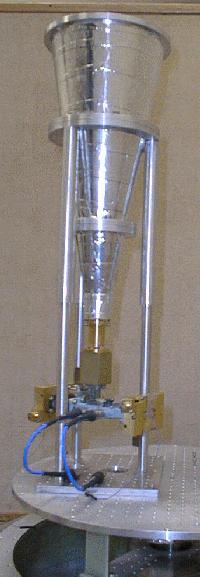
Experimental Description
POLAR is an experiment designed to detect the polarization of the CMB in a 10 GHz bandwidth between 26 GHz and 36 GHz. We will use a corrugated scalar feed horn and a HEMT based amplification chain along with a total power correlation radiometer. Polarization is typically a very small signal (~ 1%- 10% of the anisotropy signal), and it has not yet been detected, though some have tried. POLAR hopes to achieve sensitivity of a few mico kelvin over an integration period of 3-9 months to detect polarization in the cmb.

On the left you see our feed horn. On the inside of the horn, you would see the corrugations that have been cut into the metal. This feed horn has a FWHM of 7 degrees, so that this experiment probes large angular regions. In the summer of 1997, we performed a beam map using this horn as an antenna and another one like it as a source. See the results here.
From the feed horn, the signal will reach the ortho-mode transducer (OMT), which will seperate the orthogonal polarization states and send them down seperate amplifier chains.
POLAR uses dual HEMT amplifiers as its foundation, both of which will be cooled to a temperature of 15 K using a commercial cryo-cooler. After the HEMTs, the signal will encounter further (warm RF) amplification at room temperature in our radiometer box and will subsequently be correlated in a mixer. See a diagram of the entire signal processing chain here.
One advantage of performing a polarization experiment over an anisotropy measurement is that atmospheric emissions are polarized at a level much smaller than the expected CMB polarization, and thus we don't need to worry about atmospheric stability. With this in mind, we have designed POLAR to be a ground based experiment here in Madison that will be looking at the zenith of the sky at a declination of roughly 43 degrees, and we will end up with data for roughly 36 pixels in a ring centered around the zenith. Another consequence of having a ground based experiment is that we can achieve long integration times, which will greatly enhance our sensitivity per pixel.
Of course, there are good reasons why polarization has not been detected yet. Ultimately, we are looking for a signal of only a couple of micro kelvin. Until very recently, such sensitivity was impossible to achieve with even the most modern instruments and receivers. Also, polarized emissions of sources such as Synchrotron radiation, Bremsstrahlung radiation and dust emission are several orders of magnitude greater than the CMB signal in much of the spectrum.

Couple this with an increasing fleet of orbiting satellites who love to use microwaves and it may seem that the task is downright impossible. If it turns out that we cannot see the polarization signal alone, we may still be able to detect the temperature-polarization correlation because the signal to noise per pixel for the temperature maps is much better than the polarization alone. The correlated signal then would hopefully have a sn ratio greater than 1.
 Back to the POLAR
homepage.
Back to the POLAR
homepage.